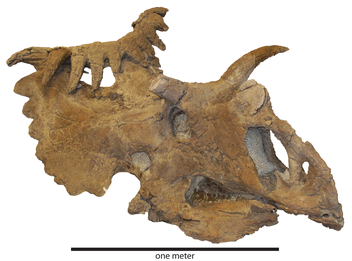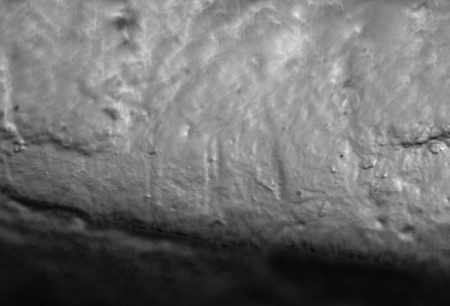Act now! Proposed US Forest Service regulations are bad for paleontology
Public lands (those areas owned by the government) are a tremendous asset to the United States, brimming with recreational opportunities, natural resources, beautiful vistas, and best of all: fossils! Many spectacular fossil discoveries within the United States originated on public lands–the elaborately horned dinosaur Kosmoceratops, swim traces of fossil fish, and even beautiful petrified wood with insect burrows, to name just a few examples from PLOS ONE. A long-standing partnership between federal agencies and scientists has been wonderfully productive. But, a new batch of federal regulations threatens paleontological research on fossils from some public lands.

A little background
Fossils found on federal lands belong to the American people. In practical terms, the arrangement has worked out quite well for everyone. If I want to collect fossils (particularly vertebrate fossils) on federal land, I first have to apply for a permit from the appropriate agency (Bureau of Land Management, Forest Service, National Park Service, US Army Corps of Engineers, etc.). In the permit, I outline my qualifications as a scientist, state the scientific purpose of my work, and list the areas where I wish to collect. If the permit is granted, I agree to abide by a quite reasonable set of rules (many in place to protect the sites for the long-term).
As an important term of the permit, I must ensure that any fossils I collect are deposited at an appropriate museum that can care for them in the long-term. For vertebrate fossils in particular, this means that the fossils cannot disappear into a private collection. But, the museum will not own the fossils either–they remain the property of the American people. Basic standards of collection care are required for any such federal repository. This is generally a good thing, to ensure that the fossils are always safe and available to researchers. For instance, a cash-strapped museum couldn’t just sell off its dinosaur bones.
In practice, museums invest a lot of resources into these fossils (usually, but not always, with minimal federal support). They cover collection expenses, preparation expenses, research expenses, and curation expenses. When it comes to research, paleontologists historically have been given pretty wide latitude, particularly once the fossils are back at the museum. As long as the museum collections managers and curators responsible for the collections are OK with a research protocol, the feds have been willing to trust museums to make decisions about collections in their care. After all, who better knows what is good for the fossils than those who work with them every day?
This is all about to change.
Good news/bad news
The 2009 passage of the Paleontological Resources Preservation Act (PRPA), as part of a big omnibus bill, was hailed by many paleontologists as a big step forward for our science. In many ways, it was–previous laws governing paleontology on federal lands had been a patchwork quilt assembled over 100 years, with some regulations MacGyvered into service from archaeology (just mention the “1906 Antiquities Act” and you’ll see a paleontologist roll his or her eyes). With PRPA passed, it was time for the relevant authorities to propose guidelines for paleontology on federal lands.
First out of the gate are draft regulations from the United States Forest Service (USFS). Released just a few weeks ago (full text available here), they’re available for public comment until July 22. There is much to like about the regulations–indeed, most paleontologists will notice little difference in how they do business. However, one section in particular is quite worrisome (footnotes are mine):
“(1) Prior to reproducing a paleontological resource, the repository will notify and obtain approval from the authorized officer*. Reproductions include, but are not limited to, molding and casting, computerized axial tomography (CAT) scans, and three-dimensional (3-D) rendering.
(2) The repository may only allow consumptive analysis of specimens if the authorized officer* has determined, in consultation with an agency paleontologist, that the potential gain in scientific or interpretive information outweighs the potential loss of the paleontological resource and provides the repository with written authorization for such use.”
–Quote from Section 291.24, “Standards for access and use of collections”
*”Authorized officer” is not someone who works for the museum–it refers to a government official. As written, they are not necessarily a trained paleontologist!

Why so serious?
If these regulations are enacted as written, paleontologists and museums will need an unprecedented level of government approval for many basic tasks. Here are just a few examples of how this might play out:
- A museum wants to replicate a Tyrannosaurus tooth found on USFS land, for public outreach. After all, it’s better than having the original specimen handled by countless people. Sorry–you’d better get the Forest Service to sign off before you even think about molding and casting that fossil.
- A museum wants to laser scan a fossil horse jaw from their collections that was found on USFS land. Gotta get permission from the Forest Service first.
- A researcher at another museum wants to make a 3D print of the aforementioned horse jaw, from the laser scan made by the museum after they acquired permission to make the scan. Sorry, you’d better check with the USFS before making that print.
- A graduate student is studying dental microwear on fossil camel teeth from the Barstow Formation. The student gets permission from the museum to mold tooth wear surfaces for her study, and buys a plane ticket and books a hotel room. While browsing collections at the museum, she finds some fossils she didn’t know about that would make an excellent addition to her study. But…they’re from USFS land. Sorry, but she’ll have to come back another time after filling out the requisite paperwork. Unfortunately, her budget is too tight, and the fossil will never make it into her sample.
- A paleontologist discovers a virtually complete dinosaur skeleton on Forest Service land, and collects the specimen after securing all of the necessary permits. It’s from a small dinosaur that looks like it could be a new species. Or, is it perhaps a young individual of another species from the same area? The best way to find out is to remove a piece of bone and study its microstructure. Previously, a collections officer at the museum could sign off on this. But in this case, the project first has to get clearance from a USFS official. They’re not terribly familiar with histology, and the agency paleontologist they consult certainly doesn’t like the idea of the skeleton from a new species of dinosaur being “damaged.” Permission denied.
Researchers and museums will be hobbled for basic scientific procedures such as CT scanning, histology, isotopic analysis, and molding/casting [important note: see clarification at the end of this post]. Indeed, the burden is such that many will just say “forget it” when it comes to working with USFS specimens. They’ll just sit in a drawer, with their full potential of scientific study never realized. This is completely against the spirit of the original legislation, and not at all what many of its supporters intended.

What’s the problem here?
In the current system, museums are trusted to make decisions about specimens in their care. After all, who knows better about what is good for fossils than qualified and trained collections managers, curators, and paleontologists? The proposed regulations would take these decisions out of the hands of the people with the most immediate knowledge of the specimens and the science, and place the ultimate decisions in the hands of individuals who may be completely unfamiliar with paleontology. Even if the official is a paleontologist, there is no guarantee that they have the expertise or background to make an informed decision about specimens they may have never seen! In the best case, the regulations could add weeks or months of waiting before basic research is allowed to proceed.
But wait…isn’t this just ensuring that rogue museum paleontologists won’t go willy-nilly with federal specimens? Not in the least! Right now, every single museum that is allowed to hold federal specimens (including those from the USFS) has to pass stringent criteria. They are held to high standards for specimen security, storage, and record keeping. If a museum has already jumped through all of the hoops to become a federal repository, it is certainly capable of being trusted to make decisions about scientific use and reproduction of specimens!
Not a scientist?
If you are not a scientist, you are affected, too. “Old” technologies such as molding and casting brought the public into contact with many fossils they never would have seen otherwise, and “new” technologies such as 3D printing have the potential to spread fossils even more broadly. The new regulations will make it much more difficult for museums and other institutions to share their specimens with the public. This is ironic, because the explanation of the proposed rules fully acknowledges the importance of fossil reproductions!
What should you do?
These regulations will have a chilling effect on paleontology, adding layers of red tape to research and outreach that have never needed it previously. Even if you don’t work on fossils from USFS land, you need to take action. As the first set of regulations from a government agency, they may well provide a template for other federal agencies (BLM, NPS, etc.) crafting their guidelines. If you study fossils from the United States, odds are quite good that the rules will eventually impact your work.
Fortunately, these regulations are not yet permanent. Read them over yourself. Submit a written comment by July 22. Encourage your friends and colleagues to do the same. Encourage your professional societies to take a stand (The Paleontological Society has already issued a statement; here’s hoping Society of Vertebrate Paleontology does also!).
The solution is simple: let the museums make decisions about specimens in their care. A simple rewording of the regulations is all that is required. This is best for science, and best for the fossils.
Update/Clarification: In some cases, a “Memorandum of Understanding” between museums and federal agencies is already in place (indeed, my own museum has some of these), that places some restrictions on the use of federal specimens (e.g., for destructive sampling). Anecdotally, these are not universally in place for all agencies. For the ones I’ve looked at, issues of digitization are not addressed yet. In any case, this is an opportunity to do things right. . .let’s remember that these are public specimens. It is not in the public’s best interest to restrict even digital access.
